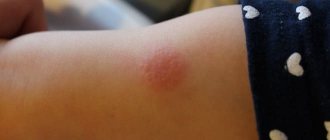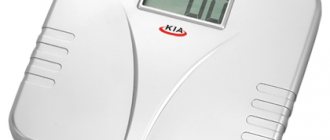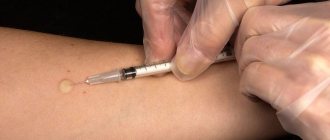Mantu test - what is it, when is it done and after how long? Many parents are not sufficiently aware of why they do a tuberculin test for children, what the child’s reaction to mantu should be and how to measure it. In this article we will try to cover these issues in detail.
Mantoux is an immunological test that detects the presence of Koch bacilli in the human body, which indicate the development of tuberculosis. This is a common vaccination given to all children from the first year of life.
Don't give up on research. Tuberculin testing is the most reliable and safe way to recognize the disease in the early stages.
Adults are prescribed X-ray diagnostics to determine infection, but for a growing organism, radiation, even in small doses, is very harmful.
How does the Mantoux test manifest itself?
The tuberculin test is carried out by injecting the child with a special drug. An intradermal injection is performed on the inner surface of the forearm; it is aimed at identifying the reaction of the child’s immune system to tuberculin.
After a few hours, a blister forms at the injection site. Gradually it thickens and turns into a reddish papule, detectable by touch and visible to the naked eye. It looks like a small flat mound rising above the skin. When you press on the papule, it turns white.
The tubercle occurs as a result of the accumulation in the skin of a large number of lymphocytes - the main cells of the immune system. They store the memory of foreign microbes that the child has ever encountered. And if the injection site is oversaturated with lymphocytes, then we can assume the presence of Koch’s bacillus in the body. A pronounced skin reaction is evidence of the active interaction of the child’s body with the causative agent of tuberculosis.
However, one should not draw hasty conclusions. Perhaps the bright redness on the skin is an allergic reaction to the components of the administered drug. Only a doctor can confirm infection with Koch's bacillus, who, after checking the Mantoux test and identifying a persistent positive result, must also prescribe additional tests and instrumental studies.
How is it done?
The injection is given intradermally, that is, into the upper layer of the skin, specially lifting the skin with the needle upward. The place where the test is performed is the forearm, usually its middle part.
Why do they do it?
Since the tuberculin test is done in childhood, many parents are interested in the question of why their children are given Mantoux.
Goals:
- Selection of uninfected children who do not have an immune response to tuberculin for the purpose of subsequent vaccination;
- analysis of the dynamics of results over several years, according to which it is possible to reasonably assume the presence of tuberculosis (“Mantoux turn”);
- identification of a pronounced (hyperergic) reaction, which always requires additional tests.
Adults generally do not receive the TB vaccine for a long time (most of us have not been vaccinated since adolescence). Therefore, in adults, the Mantoux reaction is a sensitive and reliable test for the presence of a tuberculosis pathogen in the body.
Preparation
The test is not done during any acute illness. First you need to heal.
The test method does not require any special preparation.
Composition of the drug
The tuberculin test consists of:
- Fragments of tuberculosis bacteria, thermally and chemically processed;
- stabilizer - twin-80;
- preservative – phenol;
- sodium and potassium phosphates;
- sodium chloride
- water.
Is Mantoux harmful?
The test is absolutely harmless.
The main complaints are made about phenol, which is part of the sample. Phenol is indeed a toxin. But its amount in the administered tuberculin test is so small (0.00025 g) that it does not have any effect on health.
Phenol is a natural metabolite: it is formed in tissues as a result of the activity of bacteria in the intestines. This substance is found in many foods. Phenol entering the blood is decomposed in the liver and excreted in the urine. About 0.1-0.15 g of this metabolic phenol is excreted from the body every day. This is several hundred times more than what a person receives with a tuberculin test.
The medical use of phenol in low concentrations is justified.
How often can this be done for a child?
Mantoux is done once a year.
With more frequent testing, an amplification effect is observed: the sensitivity of the immune system to tuberculin increases, resulting in the formation of a false-positive response.
There is no point in testing more than once a year.
How to correctly measure Mantoux in a child
Checking the Mantoux reaction involves measuring the diameter of only the dense mound, and not all the redness around it. At home, you can measure a child's papule using a transparent ruler.
It is necessary to assess the skin reaction in a bright room. If there is not enough lighting, you can point a flashlight or table lamp at the child’s hand. Measurements should be taken 44-72 hours after tuberculin administration.
In clinics, the test result is assessed on day 3.
Taking a measurement:
- The child sits down at the table and places his hand on its surface, palm up.
- An adult examines the papule, assesses its thickness, color, and area of redness.
- Applying a ruler to the raised part of the tubercle, the parent measures its diameter at its widest point. In this case, you can additionally use a magnifying glass.
Conclusion
You can measure Mantoux in a child at home, but only for a preliminary check. After all, after 72 hours, the papule must be examined by a medical professional. Based on the result, he decides on the need to consult a phthisiatrician.
Tuberculosis is a dangerous infectious disease. The state program for its prevention involves protecting the child from the first days of life. All healthy children are given the BCG vaccine .
Mantoux is a means of monitoring the effectiveness of this vaccination. Another of its functions is the diagnosis of tuberculosis at an early stage .
The test is performed annually. Parents have the opportunity to make sure that during the year . The amount of the administered drug is negligible, the fragments of bacteria in its composition are specially processed, the procedure does not pose a risk of infection and does not weaken the immune system.
To refuse a test means to deprive the child of additional guarantees to remain healthy in a situation where the incidence rate is quite high and is kept under control primarily thanks to vaccinations and timely diagnosis.
Interpretation of results
The normal size of papules formed at the injection site in children depends on the degree of resistance of the little patient’s body to tuberculosis infection. If the diameter of the compaction does not exceed 2 mm or only an injection mark is visible on the child’s hand, then the reaction to a tuberculin injection is called negative. With a papule measuring from 3 to 5 mm, the result is regarded as doubtful, and over 5 mm - as positive.
If the test is positive, in turn, the Mantoux dimensions are interpreted according to the following table.
| Papule diameter, mm | Reaction |
| 6-9 | Weak |
| 10-14 | Moderate |
| 15-17 | Expressed |
| 18 and over | Strongly positive |
If the child has a pronounced and sharply positive reaction to tuberculin, an in-depth examination is indicated. In case of confirmed infection with Koch's bacillus, he is prescribed a course of treatment and prevention in a specialized medical institution.
The large size of the papule formed after the injection of tuberculin always frightens parents. There is a misconception that a violent skin reaction is evidence of an active tuberculosis process in the child’s body. However, these fears are not always justified.
The Mantoux study does not provide information about the presence, distribution or localization of the tuberculosis process.
It only shows the body’s immune response to the invasion of the pathogen of this disease. A positive skin reaction indicates that the child has had previous contact with tuberculosis bacteria. However, it in no way means that this patient is sick.
Therefore, if possible, do not interpret the results of the Mantoux test yourself, but entrust this action to a specialist.
Mantoux sizes
Mantoux tests in children can cause several types of reactions to tuberculin.
What do you think are the most important factors when choosing a medical facility? Poll Options are limited because JavaScript is disabled in your browser.
Only a TB doctor can read the result correctly and make a diagnosis.
Data for decoding the results are presented in the table: Table of Mantoux test results
| Reaction | Skin manifestation of the reaction | Preliminary diagnostic results |
| Positive | Papule ≥ 5 mm. | MBT infection. |
| Doubtful | Papule 2-4 mm, hyperemia in the absence of a papule. | Requires additional examination or repeat testing. |
| Negative | There is no papule, only an injection mark. |
|
| Hyperergic | Papule ≥ 17 mm, necrosis, lymphadenitis, blisters on the skin, severe hyperemia. |
|
| False positive | Papule ≥ 5 mm. | Sensitization results in children vaccinated with BCG. |
| False negative | There is no papule, only an injection mark. | Individual immunity to tuberculin. Can be observed in unvaccinated children from birth to 6 months. |
With standard reactions
Standard test results are the following reactions:
- positive;
- negative;
- doubtful;
- hyperergic.
Assessing the Mantoux reaction as positive (papule 5-17 mm) requires additional examination of the child:
- examination by a phthisiatrician;
- X-ray (from 14 years old);
- additional diagnostic testing: Diaskintest;
- quantiferon test.
An infiltrate diameter of 2 mm to 4 mm or the absence of a papule in the presence of hyperemia (redness) is interpreted as a questionable reaction. This result is not informative and requires repeating the test. If you have a history of allergies, it is recommended to take antihistamines for 5-7 days before retesting. After performing a tuberculin test, the antiallergic course should be continued for 3-5 days.
A negative reaction (no papules or hyperemia, a needle mark measuring 0-1 mm) indicates the absence of MTB infection and immunity against tuberculosis infection.
A hyperergic reaction may be accompanied by tissue necrosis, the appearance of skin rashes and blisters, and enlargement of regional lymph nodes. Obtaining such a result may be accompanied by individual intolerance to tuberculin and violation of hygiene rules during the diagnostic period. A hyperergic response requires a comprehensive examination.
False result
A false positive response, in which the measurement of the diameter of the papule shows a result from 5 mm to 17 mm, can be obtained in children vaccinated with the BCG vaccine. To clarify the diagnostic results, a child with a positive reaction is given an allergy test with Diaskintest, which contains 2 antigen proteins that react only to actively reproducing MBT.
A false negative response may occur in children whose bodies are immune to tuberculin. In this case, the dosage of the drug may be increased.
False results can be caused by other factors and can occur in any child. Therefore, annual tuberculin diagnostics are recommended to obtain the dynamics of changes in the immune response.
Turn
Obtaining a positive Mantoux test after a history of negative test results is called a “turn” of the tuberculin test. The appearance of immune tension may indicate primary infection with MBT. This eliminates sensitization of the action of the BCG vaccine. To do this, use Diaskintest:
- if it is positive, then the diagnosis is confirmed;
- if it is negative, it is a reaction to BCG vaccination.
The results of the test performed should be deciphered and evaluated by a phthisiatrist.
False reactions
If a tuberculin test causes a local allergic reaction, the test result may be regarded as a false positive. In this case, it is advisable to repeat the study using another method, for example Diaskintest.
Parents should be aware that the test results can be negatively affected by a cold or any infectious pathology. In a sick patient, the reaction to tuberculin may be false positive, so at the time of the Mantoux test, the child must be completely healthy.
"Phenol" misconception about the Mantoux reaction
Any pediatrician will confirm to you that the Mantoux test is by far the safest and most effective “measure” for detecting active mycobacterium tuberculosis in a child’s body. However, many parents refuse to give their children annual Mantoux tests, citing the fact that the tuberculin solution used in the Mantoux test contains phenol, a toxic substance.
In fact: Phenol is a natural metabolic product that is constantly present in the body of most living beings, including humans. Phenol is actually added to the tuberculin solution as a preservative. But its doses there are negligibly small in order to cause even the slightest toxic poisoning. For example: 5 ml of human urine contains the same amount of phenol as is administered during the Mantoux test. An infant weighing about 4 kg per day excretes on average about 300 ml of urine - that is, you yourself can see that fears about phenol in the solution for the Mantoux reaction are completely unfounded.
Indications for the C-reactive protein test
- Clinical examination of elderly patients.
- Calculation of the degree of risk of cardiovascular pathology in patients suffering from diabetes, hypertension, and severe renal failure.
- Early diagnosis of strokes/pre-stroke conditions, heart attacks/pre-infarction conditions in patients with hypertension and coronary artery disease.
- Early detection of postoperative inflammation/complications
- Monitoring/evaluation of the effectiveness of medications (statins, aspirin, etc.) prevention/treatment of cardiovascular pathology.
- Diagnosis of autoimmune/rheumatic diseases.
- Detection of tumors, metastases.
- Diagnosis of infectious diseases.
- Dynamic observation and evaluation of the effectiveness of treatment of inflammation/infection.
Read further: Rheumatoid factor (Rhemofactor) is elevated in a blood test - what to do?
Read further: Test for antistreptolysin-O (ASLO) - what is it, explanation, blood norms
If a biochemical blood test shows that C-reactive protein is elevated, the cause and localization of the inflammatory process is determined, for which additional studies are carried out.
Mantoux per year: norm and deviations
A qualified specialist must determine what reaction a child has after a Mantoux test a year - the norm or whether there are deviations. But parents can themselves draw some/approximate conclusions, because there are clear definitions of all options.
| Mantoux test norm for 1 year | Deviations |
| The size of the papule is no more than 1 mm, there is no redness or induration, but there is a minimal mark from the injection | The boundaries of the papule are clearly defined, the size ranges from 1-4 mm, the edges have pronounced redness |
| There is a pronounced tubercle, the papule is very red, the size is 4 mm larger than normal | |
| The papule is 15-17 mm in size; a blister, abscess or ulcer has formed at the injection site | |
| There is no reaction at all, there is only a trace of the injection |
What should it be visually
Visually, the papule at the site of the Mantoux test should be:
- not red;
- without swelling (does not stick out much above the surface of the skin);
- without clear borders bordered by a red stripe.
The papule must have a pink tint, and this is considered an absolute norm if both the manipulation technique and the recommendations for behavior after it were strictly followed by medical workers and parents.
Normal and acceptable size
The maximum permissible papule size after the Mantoux test per year is 4 mm. And even this indicator already “speaks” of a questionable reaction, and doctors are sure to prescribe additional examinations for the baby - a visit to a phthisiatrician, identifying the likely spreader of the infection among the child’s environment.
Questionable results are often obtained if the child scratched the injection site, or if it was repeatedly urinated and rubbed with a washcloth.
Negative test
A negative test means a complete absence of papule or redness; the doctor can visually determine only the injection site. And this result is not always good, because most often it means a complete lack of immunity to the tuberculosis pathogen. This happens even if the newborn was given BCG in the maternity hospital.
Big Mantoux, good or bad
Large Mantoux is often perceived by parents as positive or bad, but doctors say that the size of a papule 4 mm larger than normal does not always mean the presence of Koch’s bacillus in the child’s body. The reasons for these results may be:
- allergic reaction to the administered drug;
- abnormal behavior of the child in the first 72 hours after the test;
- violation of the technique of administering tuberculin by a medical worker;
- introduction of an infectious agent into a puncture during injection.
At the age of 1 year, the size of a papule/redness at the Mantoux site is considered normal to be up to 11 mm. This indicator is typical for those children who were given BCG in the first week of life. It means that the child’s body has already encountered Koch’s wand and fought against it. Only at 3 years old will the papule begin to shrink and reach standard size.
At-risk groups
These include people who have one or more factors from the list:
- lack of permanent residence;
- a history of tuberculosis with pathological changes in lung tissue;
- diseases of the respiratory system in chronic forms;
- contact with tuberculosis patients;
- low social living conditions;
- pathological response to various diagnostic tests.
The doctor determines further tactics after a standard examination. Redness and changes in the size of the lump after the reaction are not grounds for asserting the presence of a disease. The assessment of the result depends on many factors that guide the specialist when making a diagnosis. For this reason, this diagnostic reaction is not a completely reliable research method.
In some cases, a positive response may be associated with the presence of inflammation in the human body or with previous diseases. In addition, vaccination in rare cases can cause the development of allergic reactions due to the presence of preservatives in its composition.
The test is often carried out for the purpose of prevention to detect the disease in the early stages. Therefore, knowledge of possible complications of the reaction is a necessary point to prevent serious consequences in the child’s body.
Sample schedule
As before vaccination, before the Mantoux test, about a month in advance, you should make sure that the baby is feeling well. He must be healthy, he must not have any acute diseases or allergies. If the child has a fever, it is better to postpone the test date to a later date.
You cannot do a test if a child has skin diseases, especially during an exacerbation, if he has a history of diagnoses of “Bronchial asthma,” and also if the children’s group that the child attends is currently in quarantine. All of these are strict contraindications.
Children and adults are not allowed to undergo testing if they have recently suffered an acute illness. Mantoux should not be given to patients with a cold, cough, fever, sore throat, or suspected flu.
If a person received any type of vaccination less than a month ago, the test will have to be temporarily postponed. Procedures that affect the immune system are a contraindication to the test (except for taking weak strengthening drugs).
The specialist will not administer tuberculin if a rash, hives, or other signs of allergy have been detected on the skin.
The test is not done even when a viral or infectious disease was suffered less than a month ago. To carry out a full reaction, you must wait until 30 days have passed from the moment of recovery.
Many people call the Mantoux reaction a vaccination. However, the test is not one of those, but it is still included in the mandatory vaccination schedule. As a rule, the first tuberculin test is performed on children when they reach the age of one year. When antigens are administered to a baby before this period, there is a high probability of skin reactions that will interfere with seeing a reliable picture.
In addition, when administering the Mantoux test before one year of age, a false positive test result is possible due to the fact that the infant’s body has a high concentration of antibodies to tuberculosis after BCG vaccination
It should be noted that Mantoux is also administered to those children who, for some reason, have not been vaccinated against the disease.
The child’s body’s response to tuberculosis is checked annually until the age of 14. It is recommended to do the test at the same time of year. For example, if the previous check was carried out in the fall, then the next one should also be done around this time. Children who are not vaccinated against the disease should be tested 2 times a year. If a child has had contact with a patient with tuberculosis, the test is performed 3-4 times a year.
Mantoux sizes
With standard reactions
There are several main results of the Mantoux test:
- negative;
- positive;
- doubtful.
A negative result is recorded if after a tuberculin injection there is no reaction on the skin, except at the site of the puncture itself. There will also be no seals.
An acceptable negative reaction is considered to be a pinpoint reaction measuring 1 mm.
A positive reaction is when, after the administration of tuberculin, on the 3rd day the papule reaches a diameter of 5-16 mm. This is considered the norm.
For children, the norm is 5-15 mm. This indicator indicates that the body has good post-vaccination immunity after BCG vaccination. If deviations from the norm occur without prior vaccination, this may indicate a disease. This means there is an indication for further diagnosis.
Note! If the papule becomes smaller over the years, then the reason for this is a decrease in immunity against mycobacteria. A questionable reaction is a condition in which the papule reaches a size of 2-4 mm
In this case, there will be no compaction, but only redness. Based on such indicators, it is difficult for a doctor to determine whether a person has immunity against infection. That is, it may not exist or it may be very weak. A questionable result is an indication for visiting a TB specialist.
A questionable reaction is a condition in which the papule reaches a size of 2-4 mm. In this case, there will be no compaction, but only redness. Based on such indicators, it is difficult for a doctor to determine whether a person has immunity against infection. That is, it may not exist or it may be very weak. A questionable result is an indication for visiting a phthisiatrician.
There is also a hyperergic reaction. It is characterized by redness at the injection site of more than 17 mm in children and more than 21 mm in adults. In this case, ulcers may appear with the release of pus, and the lymph nodes may also enlarge. That is, an increased reaction to tuberculin appears.
False result
The Mantoux test can often exhibit false reactions; there are 2 types:
- false positive;
- false negative.
In the first case, an enlarged papule forms on the skin, which exceeds the age norm. If such a situation occurs, the child is referred to a TB specialist. The doctor conducts a survey of the patient or parents, as a result of which the reasons for the occurrence of a false positive reaction are determined. This can be mechanical damage to the papule, that is, rubbing, combing, covering the papule with a band-aid, etc.
Another false positive result may occur due to an allergic reaction that occurred at the site of tuberculin injection. In some people, it occurs due to the phenol included in the drug. This component is a preservative, which is very toxic to the body.
A false negative reaction is the absence of papule and redness after tuberculin administration, although the body has an immune response. This means that the person is infected, but the test did not show it.
A false positive Mantoux test result can be due to various reasons:
- Testing for children under 6 months. At this age, the child’s body is not able to adequately respond to the drug, so false reactions are guaranteed.
- If a person was infected with tuberculosis about 10 days ago. In this case, mycobacteria are still “sleeping” in the body; they begin to actively multiply after this period.
- Immune disorders. In this case, the body, due to a pathological factor, is not able to respond to tuberculin. This is observed in patients with severe immunodeficiency (HIV, etc.). If a child is diagnosed with any pathologies of this nature, the dosage is prescribed significantly more.
Turn
The turn of the Mantoux test is recorded if the sample becomes stronger with each subsequent year. Namely:
- manifestation of a positive test after several negative ones.
- An increase in the size of the papule by 6 mm compared to the previous test.
- Papule after tuberculin injection in a child is less than 12 mm after 3 years from vaccination.
Normal in children
Anti-tuberculosis immunity after the first vaccination lasts up to 7 years. Exactly how much can be judged approximately by the round scar left on the left shoulder from the vaccination.
Table 1. Preservation of anti-tuberculosis immunity after BCG vaccination depending on the diameter of the post-vaccination scar.
| Diameter of post-vaccination scar, mm. | Duration of anti-tuberculosis immunity, years |
| up to 2 | until 3 |
| up to 4 | up to 4 |
| until 6 | up to 5 |
| 8 or more | up to 7 |
If there is no scar, it means that the vaccination was not carried out, and the child does not have immunity against tuberculosis;
The size of the scar matters when answering the question of what the reaction to Mantoux should be in children.
Which Mantoux is considered normal depends on the age of the child. Let's look at it in detail.
Norm for 1 year
During the second year of life, all children have a positive or questionable reaction to Mantoux.
The norm at 1 year in the presence of any post-vaccination scar is a papule with a diameter of 5 to 10 mm.
Normal for 2-6 years
By the age of 2, the intensity of anti-tuberculosis immunity is maximum.
With a post-vaccination scar of more than 8 mm, the normal size of Mantoux can reach 16 mm. After 3 years of age, the immune response to tuberculin begins to fade. But still, at 4 and 5 years old, most children retain a dubious or positive reaction. The normal size of a papule at the age of 4-6 years is considered to be no more than 10 mm.
In order to understand what size Mantoux should be at this age, you should correlate the diameter of the papule with the post-vaccination scar:
Table 2. Correlation between the normal size of the papule and the size of the post-vaccination scar in children aged 3-5 years.
| Diameter of post-vaccination scar, mm. | Papules norm, mm |
| up to 2 | no reaction |
| up to 4-6 | 5-6 |
| 6 or more | to 10 |
At 6-7 years of age, children almost always show a negative or questionable response to the test. This suggests that the immune system “forgets” how to respond to tuberculosis pathogens. A negative reaction at any age indicates the need for re-vaccination. Routine revaccination of all children is carried out at 7 years of age.
Normal for 7-14 years old
After revaccination at 7 years of age, the cycle repeats.
- During the first 3 years, the maximum intensity of immunity is maintained;
- after 10 years, the response to injected tuberculin fades;
- By the age of 13-14 years, most adolescents will have a questionable or negative response to the test.
Table 3. Norm of Mantoux papules in children 7-14 years old
| Age, years | Papules norm, mm |
| 7-9 | 10-16 |
| 10-12 | 5-6 |
| 13-14 | 0-4 |
Mantoux at 6 years old
At six years of age, the child’s immunity is still present, although it is of minimal importance. For some children it runs out. The Mantoux test is very important at this age. It allows you to detect infection at a very early stage, before the child develops symptoms of the disease, including changes in the lungs. A positive reaction to the Mantoux test at six years of age (as well as a positive reaction in adults) is a reason to think about the possibility of infection and the need to conduct additional examination.
Purpose
The Mantoux test is designed to determine which of the tested children is at risk. The diagnosis of tuberculosis infection is not made solely on the basis of this test; its advantage is its simplicity and widespread nature.
If a six-year-old child has a positive Mantoux reaction, the pediatrician refers him to a phthisiatrician for additional examination.
Checking reactions in children
To clarify Mantoux’s results, one of the alternative tests is prescribed, for example, Diaskintest. It reacts only to infection with tuberculosis, eliminating most of the false-positive reactions associated with infection with other, non-tuberculosis mycobacteria
If the diaskintest result is negative, the positive Mantoux reaction is not taken into account; most likely it was caused by extraneous causes
After the diaskintest (or instead of it), a quantiferon test is also performed. Unlike Diaskintest and Mantoux, it has no contraindications; it can be done when the patient has a cough, runny nose, high temperature, exacerbation of a chronic disease or an allergic condition of the body.
One of the first manifestations of tuberculosis in the body of an adult and a child is changes in the lungs. Therefore, in the tuberculosis clinic, not only all adults, but also children who have passed the Mantoux test with a positive result, first of all undergo fluorography.
If the result of the study shows that changes are present, the next step will be an x-ray of the lungs. A centimeter-detailed picture of the lung tissue in different projections will make it possible to see where the disease is localized and assess the degree of its severity.
A general blood test for tuberculosis is prescribed both after Mantoux and instead of it. If tuberculosis in a child is asymptomatic, it will allow us to see the presence of the pathogen or traces of its vital activity in the blood. With the disease, characteristic changes are most often noted in the leukogram. In addition to the blood test, sputum (the pathogen can also be detected in it) and urine (to determine whether the kidneys are affected by tuberculosis) are prescribed.
The enzyme immunoassay method allows you to find in the blood antibodies produced by the body to protect against tuberculosis. ELISA is especially important for latent forms of the disease. The DNA of the pathogen bacteria (both in the blood, sputum, and urine) will be detected by the polymer chain reaction (PCR) method, one of the most accurate.
Why do this
The Mantoux reaction is done subcutaneously by injecting a special solution. It contains tuberculin - inactive particles of the causative agent of the disease, Koch's bacillus. The substance is safe for the body and cannot cause tuberculosis, however, it is used to test the presence of immunity against the Koch bacterium.
The fluid accumulates under the skin and forms a button. If Mantoux tests are performed annually, the patient's hands are constantly changed: alternating right with left.
The level of immune reaction is determined by the size of the button that forms at the site of injection of inactivated Koch bacilli. The larger and brighter the color, the more likely it is that the patient has ever been in contact with the causative agent of the disease. If a person is currently infected with tuberculosis, as a result of the injection of the substance, suppuration may even develop at the injection site after some time.
Determine whether a child or adult is at risk of contracting tuberculosis by checking the Mantoux indicators (button size) with the normal values in the table. When making comparisons, a permissible deviation of several millimeters is taken into account, but if the compaction clearly exceeds the norm, the patient is sent for additional examinations with suspected tuberculosis.
The vaccination, aimed at ensuring that the child develops anti-tuberculosis immunity, is done in the maternity hospital. It's called BCG. However, despite vaccination, a child can become infected with tuberculosis, although the vaccine significantly reduces this likelihood. This is due to a gradual decrease in antibodies to the tuberculosis bacillus. If the baby has not developed immunity at all after the first vaccination, he is given a second one - before school, at the age of 7 years.
The Mantoux test should be performed once a year, starting from the moment the child turns 1 year old. If the test gives a negative result, this is interpreted as the fact that immunity to the tuberculosis bacillus has not been formed after the maternity hospital vaccine, and for such babies the doctor has the right to recommend a tuberculin test not once, but 2 times a year, so as not to “miss” the disease.
According to the existing rules, samples must be taken in different hands. If this year the child was treated on the left, then in a year it should be done on the right. The place for tuberculin injection is always the same - the inner surface of the forearm, its middle third. If you see that the test was made in the other third of the forearm, you can’t count on the correct result.











